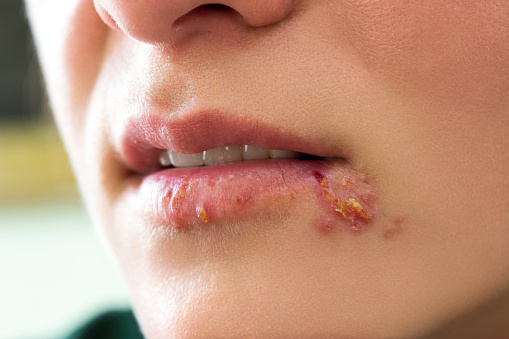Firstly HSV2 and HSV1, better known as the cold sore virus, are just two of a related group of seven viruses that are known to infect humans. Others include the Varicella-Zoster virus, commonly known as chicken pox and shingles. Diagnosis of infection with either HSV1 or 2 can be established with a blood test known as the Western Blot test; the upside of this test is that a patient who does not have active lesions may be diagnosed through the presence of antibodies to either strain. Accuracy of this test is only 90-95% depending on the lab involved. Some instances have occurred where patients were diagnosed with either a false positive or a false negative. The most accurate diagnosis is with a physician taking the top off a fresh lesion, obtaining a swab from the base of the lesion and a lab growing a viral culture from it. Extracting a viable swab from the lesion can be quite painful for the patient.
HSV2 traditionally involved infections in genital areas, with the virus lying dormant in the sacral nerve at the base of the spine during periods when the patient is not experiencing lesions. HSV1 traditionally involves infections around the mouth and nose and lies dormant in the trigeminal nerve in the neck during non-active phases of the disease. Current epidemiology studies across the Western World indicate the incidence of HSV2 to be around one in eight people, or 12% of the population. Only one in five of those with antibodies have been diagnosed.
In real terms, in a room containing forty people, five have HSV2 but only one knows they have it. A further three of the five may have had an isolated symptom once or twice. This would have appeared so insignificant that they mistook it for a pimple, infected hair follicle or a boil. The final one in five is someone who has never had a symptom and may never do so. For this patient, and the other three undiagnosed patients, accusations of infection (generally followed by accusations of infidelity) from a partner are often met with counter accusations and disbelief. A conservative estimate of the world population with HSV1 antibodies and the ability to infect others is around 90%. Of these, roughly 45% are symptomatic. If you have been diagnosed with either infection, it is very possible you contracted it from someone who has no idea they have it themselves.
People have received the messages about safe sex and changed some of their practices, believing that only penetrative sex requires safe sex. Sexual health specialists now report that half the new HSV diagnoses in clinics have been microbiologically confirmed as HSV1 on the genitals, in the general community it is now estimated that 20% of all herpes infections in the genitals are in fact HSV1. On the plus side for the infected patient, when the HSV virus is not living in its ideal host environment (i.e. HSV1 infection of genitals, oral HSV2 infection) infections have been generally documented to be less severe and happen less frequently.
Another mistake many patients make, is assuming that they are not infectious during a dormant or asymptomatic phase of their disease. Studies have shown that even when a couple who are clinically discordant (i.e. one is positive and the other is negative) use what is recognized as gold standard treatment for reduction of risk to partners, the rate of transmission in a 12-month period is still 10%. This management of infection control involves the use of condoms during all sexual encounters and complete abstinence from sex during the positive partner’s symptomatic phases. Interestingly, sexual health experts report that if one partner has remained negative for 10 years in a clinically discordant partnership, it is very unlikely that they will contract the disease after this time. It is speculated that they have some immunity/protection either natural or acquired that science has not yet managed to identify.
A true primary infection of HSV2 can last for up to ten days, it involves a systemic response, where all the glands in the body are swollen, much as if the patient has influenza, as well as the obvious genital burning, itching, pain with urination or complete inability to urinate. Many patients think they are presenting with a primary infection, but, severity of symptoms indicates to the physician, this is in fact a recurrence. In these cases the patient’s primary infection would have been asymptomatic, but, for some reason, they have become run down and their immune system is not responding as it did when they were first infected. These and subsequent recurrences of HSV2 are usually around five days in duration, unless there is a serious immune system deficiency. In this case, the treating physician should refer the patient for further testing.
Because HSV transmission requires skin-to-skin contact and viral shedding to occur, typically an infection of HSV2 is specifically confined to the genitals. Affected areas include the vulva and labia in women and penis and scrotum in men, due to penetrative intercourse being quite localized. Where a patient has been infected with HSV1 on the genitals, the area is usually larger and vesicle distribution more extensive due to oral sex skin-to-skin contact covering a more extensive surface area of the genitals. Both viruses may be treated effectively with anti-viral drugs.
As stated earlier, each virus has its ideal host environment. For the patient infected with HSV1 on the genitals, this means subsequent infections are usually less virulent, and in some cases may only ever recur once or twice in their lifetime. For the patient infected with HSV2 on the genitals, the incidence of recurrence can vary greatly. Recurrences are related to the health of the immune system. Triggers may include stress, poor diet, lack of sleep, sunburn and in some women, their menstrual cycle. During the first year of infection, the number of recurrences may range from one to twelve, with an average being four to five. During subsequent years the immune system responds better, the patient learns what will trigger a recurrence and usually tries to avoid it. Eventually most patients can experience as few as one to two recurrences per year. Also, as the patient learns to better recognize the symptoms of an impending recurrence, they are able to administer anti-viral drugs earlier. This can minimize the length and duration of the attack, and possibly prevent lesions altogether. It is important for the patient to remember that despite avoiding a recurrence, they are still shedding the virus and they are still potentially infectious to their partner.
Maintenance doses of anti-virals may be taken daily to reduce the number of recurrences. Up to 50% of patients on these therapies report an absence of recurrences in a 12-month period. Where this therapy is discontinued, patients almost certainly will experience a recurrence within three weeks. This is generally followed by a reduction in the number of annual recurrences. There are a small number of female patients who have required this maintenance therapy with anti-viral drugs continuously since they first became available, over 15 years ago, in earlier forms. As recurrences reduce in frequency and severity, most patients eventually come to terms with their diagnosis. For some, this is never the case, sexual health physicians report that they need to refer between 10-20% of their patients for further psychological counseling. This is in spite the fact that they are very experienced with the disease counseling required for this diagnosis.
What is important, regardless of how well patients appear to cope with the initial diagnosis, is ensuring access to information. This can be obtained readily and anonymously from www.herpes.com, or visit our Brand website and Facebook Page Messenger Chat-Bot for more information about Herpes Topics. Although HSV2 is a lifelong infection, with the right management and care it is not necessarily symptomatic, nor should it impede the patient from enjoying a loving and long-lasting, secure relationship.
SUBSCRIBE NOW!
Enter your email address:



